In this article:
Ringworm, or tinea, is a group of fungal skin infections that are characterized by the appearance of red, circular, itchy rashes with raised, scaly borders and clear skin in the middle. These rashes are shaped like a ring or a coiled worm, hence the name of this infection.
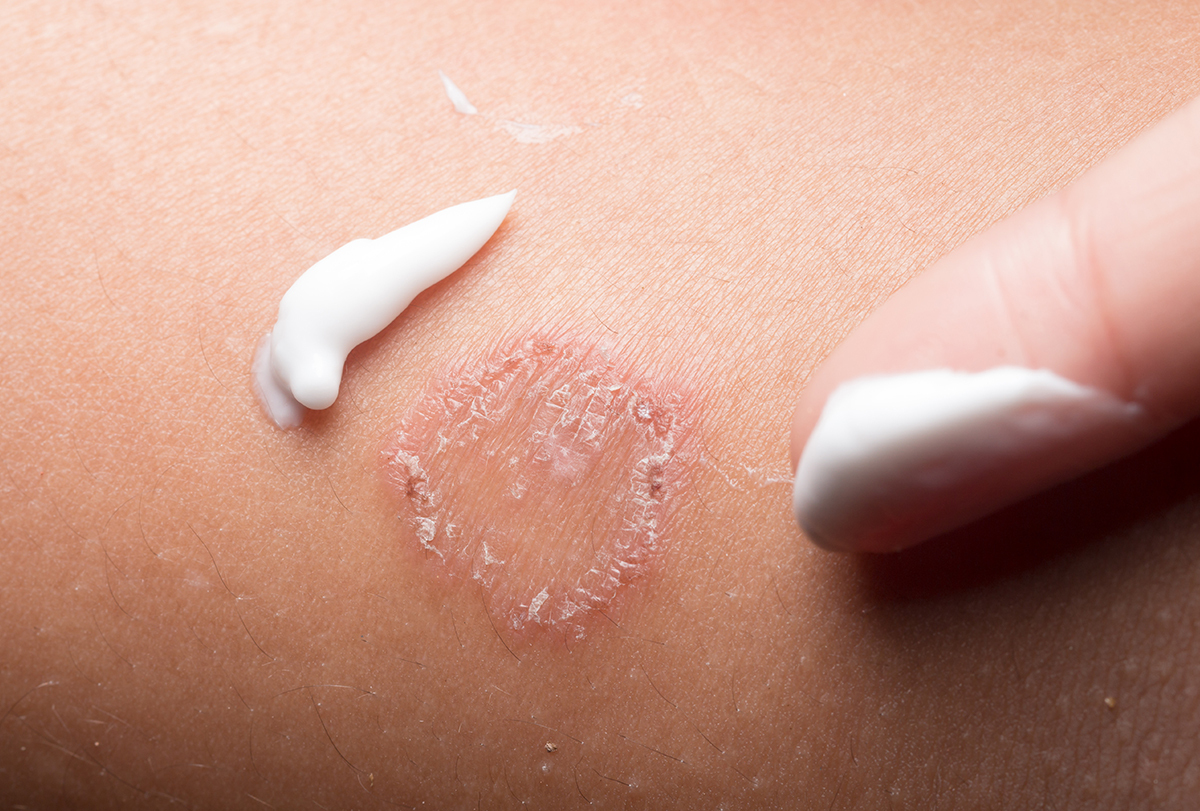
The fungus responsible for this infection thrives in warm, humid conditions and therefore mostly affects the closed sweaty areas such as the groin, scalp, space between the toes, and skin folds in overweight individuals. (1) It can, however, infect any skin area on the body and is often known by different names depending on its location.
Ringworm is extremely common and affects people across ages but is especially prevalent among children.
Types of Ringworm
Ringworm is a broad term that encompasses several different types:
- Athlete’s foot (tinea pedis) refers to ringworm of the foot, which is one of the most prevalent fungal skin infections. It produces the characteristic ring-shaped rash that may even blister. The symptoms usually start in the area between the toes and can then spread to the surrounding skin, sometimes even to the toenails. If you are not careful enough in handling the infected foot, the infection may spread to your hands, which is known as tinea manuum. (2)
- Jock itch (tinea cruris) affects the genital area, which traps a lot of heat and sweat due to its closed location. The infection is marked by the appearance of a red, itchy rash that may take time to heal and may recur. This infection is so named because it mostly affects jocks or male athletes. Generally speaking also, jock itch is largely a male problem and rarely affects women. (3)
- Scalp ringworm (tinea capitis) occurs when the ringworm fungus infects the skin of the head. This infection mostly targets children but can sometimes affect adults. (4)
- Onychomycosis is ringworm of the nails, which causes them to become thick and deformed. This infection targets toenails more commonly than fingernails. (5)
- Body ringworm (tinea corporis) refers to a ringworm infection occurring on body parts other than the face, foot, genital area, scalp, and nails. Body ringworm is most commonly seen in children; however, it can affect people of all ages. (6)
Causes of Ringworm
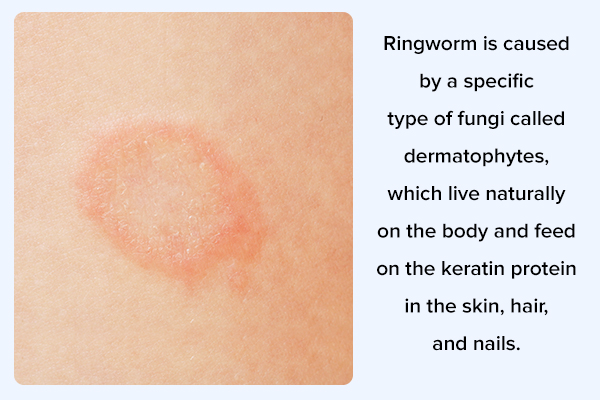
Ringworm is caused by a specific type of fungi called dermatophytes, which live naturally on the body and feed on the keratin protein in the skin, hair, and nails. Dermatophytes are a normal part of the skin’s microbiome and are unlikely to cause any harm so long as they don’t overgrow.
Some areas of the skin trap a lot of heat and moisture, favoring the rapid proliferation of these microbes, resulting in an infection.
Children are most likely to pick up this infection in the following ways:
- Skin-to-skin contact with an infected person, which is especially prevalent among those who play contact sports
- Walking barefoot on the damp floors of public showers, community swimming pools, or gym locker rooms, which are common breeding grounds for the ringworm fungus
- Touching or petting an infected animal
- Contact with contaminated soil
- Using the personal items of an infected person
- Touching any surface or object contaminated with the fungus
Symptoms of Ringworm
Ringworm typically presents the following symptoms 4–14 days after first exposure:
- A circular patch develops with a scaly, red, raised boundary that resembles a ring.
- The patch grows usually ½–1 inch (12–25 mm) in size.
- The redness at the center of the ring gradually fades as the lesion expands.
- The rash tends to be itchy and discomforting.
- Hair loss around the rash occurs if it appears on the scalp.
- A cluster of tiny black specks on the scalp develops, which are actually stubble of hair that has broken from the roots.
- Scalp ringworm can sometimes trigger a severe reaction in children called a kerion, which leads to swelling, pain, and pus in the affected skin, sometimes accompanied by fever.
- If your nails get infected, they may turn yellow and thicken at the ends.
- If your foot gets infected, the skin may crack and become scaly, especially in the area between the toes.
- Athlete’s foot can also lead to the development of fluid-filled blisters.
Treatment for Ringworm
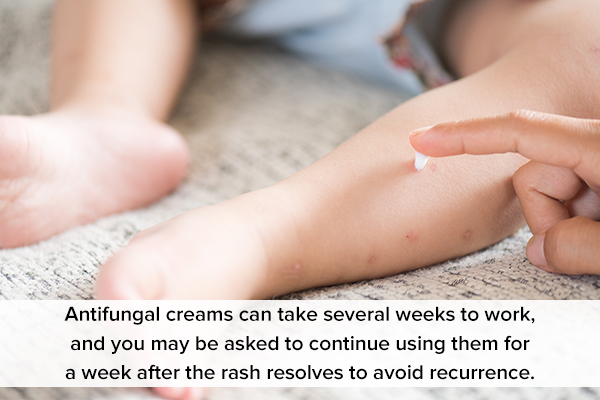
Some ringworm infections resolve with simple over-the-counter antifungals, while others may require prescription drugs. Your doctor will recommend the appropriate treatment after taking into account the following relevant factors:
- Type of symptoms
- Severity of the condition
- Child’s age
- Child’s overall health
Over-the-counter treatment
Doctors generally recommend the following interventions to treat mild cases of ringworm:
- Topical antifungal soaps, washes, and powders: These topical treatments can help kill the fungus to reduce the severity and duration of the ringworm infection.
- Antifungal creams: These creams can take several weeks to work, and you may be asked to continue using them for a week after the rash resolves to avoid recurrence.
- Zinc supplements: Ringworm, or other fungal infections for that matter, can be indicative of a weak immune system or high oxidative stress. Zinc acts as an antioxidant that helps manage increased oxidative stress by fighting free radicals in the body and, therefore, may be helpful.
Oral medications
If your child’s condition does not respond to over-the-counter treatment, the doctor may prescribe the following medications to be taken along with the topical antifungals:
- Antibiotics are generally prescribed to treat different types of ringworm infections, with some kids requiring a longer course than others.
- Griseofulvin (Grifulvin) is an oral antifungal that is available as a tablet, capsule, or tonic. It is a standard medication for the treatment of all kinds of ringworm infections and is recommended only in children above the age of 3.
Diagnosing Ringworm
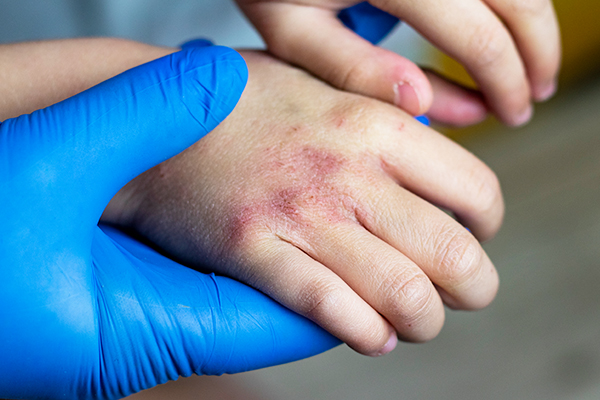
Ringworm can be confused with several other skin conditions that present similar symptoms, so a proper diagnosis is needed before deciding on the treatment.
Generally, the doctor will inquire about your child’s medical history and symptoms before proceeding to a physical exam. If there is still some doubt, the doctor will order a culture or skin scraping of the rash to be examined in a lab for signs of the ringworm fungus.
Lifestyle Changes
Here are a few self-care guidelines that can help your child recover faster from ringworm while also reducing the possibility of secondary infections:
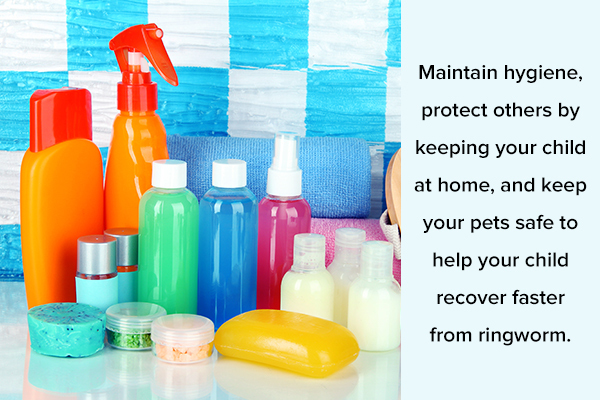
- Proper hand hygiene: Make your child wash their hands with soap and warm water every now and then but especially before eating or handling food and after using the bathroom, touching the infected skin, or playing with pets.
- Maintain personal hygiene: Keep the infected skin clean and dry to limit the growth of the fungus and speed up skin healing. Wash it daily with an antifungal soap and water. Make sure to remove any trace of water or sweat from the area by letting it air-dry or lightly dabbing a soft, clean towel that is only meant for your personal use. Moisture promotes fungal overgrowth, which can worsen or prolong the infection.
- Maintain nail hygiene: Keep your child’s fingernails and toenails short, clean, and filed. Children often scratch the itchy rash despite being told not to, and doing so with sharp, long, or dirty nails can further damage or contaminate the infected skin.
- Protect others by keeping your child at home: Ringworm spreads through direct contact with infected skin or contaminated surfaces. Thus, keep your child out of school and away from contact sports so that they don’t infect others. Mild infections are generally not a threat, but severe ones can be highly contagious.
- Keep your pets safe: Ringworm can affect animals too; thus, you need to keep your child away from any pets in the house as long as the infection persists. If you do notice your pet losing excessive hair or developing bald patches, consult a vet immediately as this could be the beginning of a fungal infection.
Preventive Tips
Here are few tips to keep your child safe from ringworm infections and reinfections:
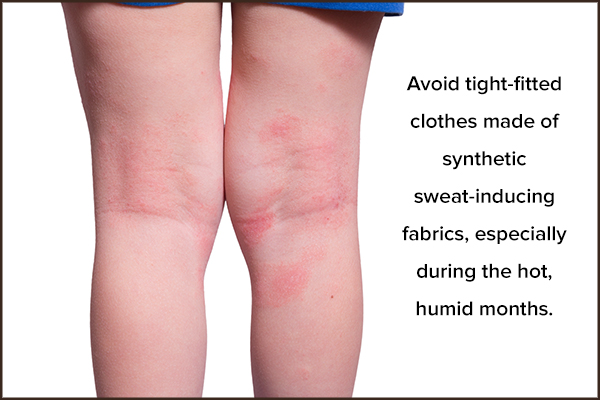
- Keep separate towels, combs, or bedsheets for your kids that are not to be shared with anyone else.
- Make your child wear soft, breathable fabrics to keep their skin properly ventilated and to prevent sweating. Avoid tight-fitted clothes made of synthetic sweat-inducing fabrics, especially during the hot, humid months.
- Make sure your child wears slippers when going to communal pools, gymnasiums, locker rooms, and public showers. The warm and humid conditions of these spaces allow the ringworm fungus to flourish on their floors. Walking barefoot on these contaminated grounds can give your child athlete’s foot, so it is imperative that they always wear their slippers when visiting these high-risk sites.
- Children can contract ringworm from other infected children while playing contact sports. If your child is into contact sports, make sure they shower after every practice.
- Use hot water and a disinfecting solution or soap to regularly wash the floors in your house that your children walk barefoot on. This is important to keep your child safe from fungal foot infections such as athlete’s foot.
- Educate yourself about the signs of ringworm infection, and seek immediate medical consultation if your child shows any of them. Ignoring or dismissing them as nonserious will only make the problem worse and will increase the risk of transmission. Early treatment, on the other hand, will lead to faster resolution of the problem without any complications and also will contain the spread of the infection.
- Prohibit your child from scratching the rash as this may transfer the fungus to other parts of the body, spreading the infection. Plus, the friction can rupture the already-damaged skin.
- If your child contracts athlete’s foot, put some antifungal powder or spray in their shoes to kill any fungal growth inside it. Continue doing this even after they recover to minimize the risk of reinfection.
Risk Factors for Ringworm
The following factors can predispose your child to a ringworm infection:
- Living in a hot and humid environment
- Poor hygiene
- Poor diet
- Compromised immune system because of illness or medicines
- Participating in contact sports such as wrestling
- Frequenting communal baths, public pools, gyms, or locker rooms
Complications of Ringworm
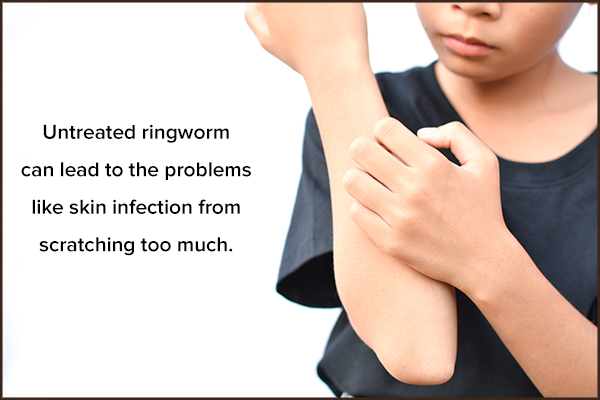
Severe or untreated ringworm can lead to the following problems:
- Hair loss if it affects the scalp
- Secondary skin infection from scratching too much
When to See a Doctor
See your child’s doctor if you notice any of the following signs despite following the doctor-recommended treatment:
- The rash grows in size or spreads to other parts even after 1 week of treatment.
- The rash or the infected skin becomes increasingly red and swollen.
- Pus or fluid oozes from the rash, which is a sign of infection.
- Bald patches occur on the scalp.
- There is no improvement despite two courses of appropriate treatment with oral antibiotics and a medicated shampoo.
Final Word
Ringworm is highly contagious, so you must keep your child away from group settings, including schools and playgrounds, until the infection goes away.
Early treatment is the best way to prevent spreading the infection to other parts of the body and to other people. Fortunately, with over-the-counter and prescription medicine, ringworm typically goes away completely and without long-term consequences.
- Was this article helpful?
- YES, THANKS!NOT REALLY


